Cats are notorious for their love of sleep, often spending up to 16 hours a day dozing. If you’re a cat owner, you’ve likely witnessed your feline companion in a variety of sleeping postures, some of which might seem downright bizarre. But have you ever wondered what these positions mean? Understanding your cat’s sleeping habits can offer a fascinating glimpse into their comfort level, health, and even their wild instincts. Whether your cat is curled up in a tight ball or sprawled out exposing their belly, each sleeping position tells a story. Let’s delve into the world of Cats Sleeping and decode 20 common positions to better understand your beloved pet.
1. Curled Up in a Ball
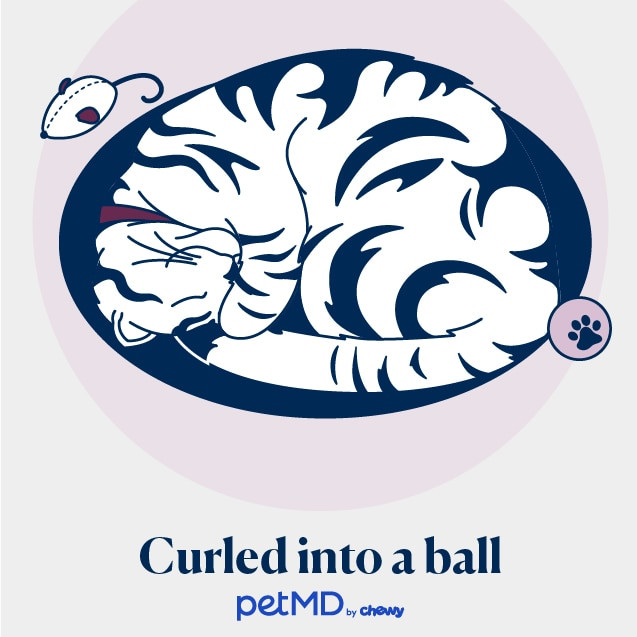 A cat deeply asleep, curled up in a tight ball with its nose tucked into its tail, showcasing a typical posture for heat retention and protection.
A cat deeply asleep, curled up in a tight ball with its nose tucked into its tail, showcasing a typical posture for heat retention and protection.
One of the most frequently observed cats sleeping positions is the classic curl. Cats often sleep curled up in a ball, nose to tail, for a very practical reason: warmth. This posture is highly effective for conserving body heat, especially in cooler environments. Beyond warmth, the curled position is also instinctual for protection. By tucking themselves into a tight sphere, cats safeguard their vulnerable abdominal organs, shielding them with more resilient muscle and bone. This is a holdover from their days as both predator and prey in the wild, where self-preservation was paramount.
2. Sleeping on Their Back
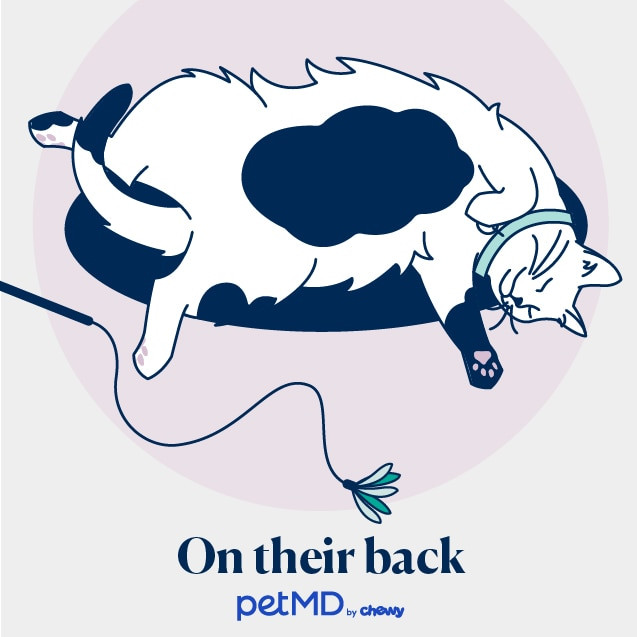 A relaxed cat is pictured lying on its back, belly fully exposed and legs outstretched, indicating a state of deep comfort and security in its environment.
A relaxed cat is pictured lying on its back, belly fully exposed and legs outstretched, indicating a state of deep comfort and security in its environment.
Seeing a cat sleeping on their back, with their belly fully exposed, is a sign of ultimate trust and relaxation. Cats instinctively protect their vulnerable organs, so displaying their abdomen in this manner indicates they feel exceptionally safe and secure in their surroundings. When your cat sleeps on their back, it’s a high compliment to the safe environment you’ve provided.
However, even in this vulnerable and trusting position, resist the urge to rub their belly. While it’s a sign of comfort, most cats still have a strong protective instinct regarding their abdomen and may react defensively, even if they generally feel safe. Belly rubs are often a feline faux pas!
3. Side Sleeping
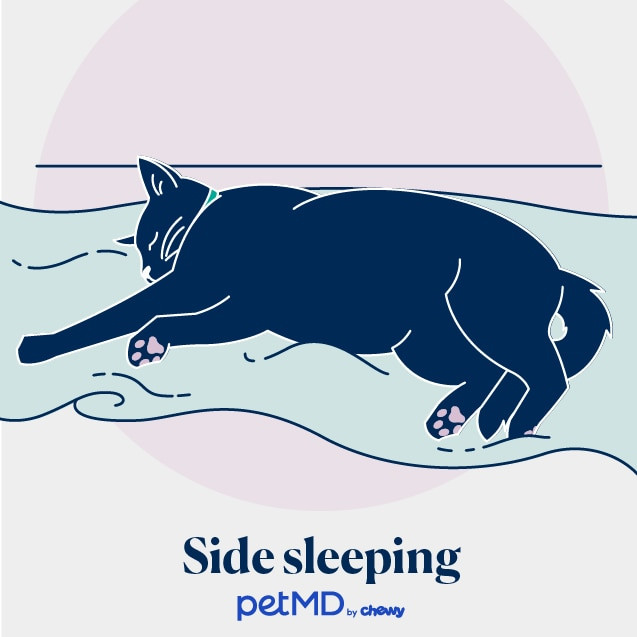 A cat is peacefully sleeping on its side, legs gently stretched out, representing a comfortable yet alert posture that allows for quick reactions if needed.
A cat is peacefully sleeping on its side, legs gently stretched out, representing a comfortable yet alert posture that allows for quick reactions if needed.
Similar to sleeping on their back, cats sleeping on their side with legs stretched out also expose their vital organs, signaling comfort and trust. This position suggests your cat feels secure enough to let down their guard around you.
A key advantage of side sleeping, however, is the ease of escape. While relaxed, a cat in this position can quickly spring up and react if they sense danger. This blend of relaxation and readiness is a testament to their dual nature as both predator and prey. Side sleeping allows them to achieve restful sleep while maintaining a degree of alertness.
4. The Loaf Position
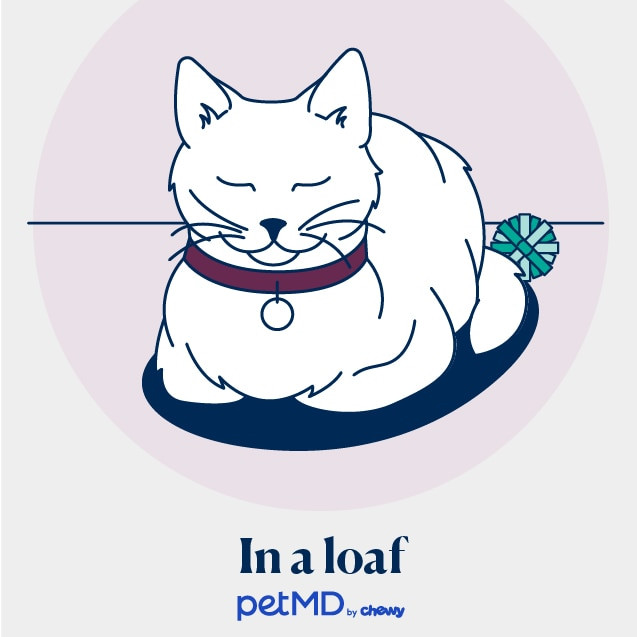 A cat is shown in the loaf position, paws tucked neatly underneath its body, head held upright, demonstrating a state of relaxed alertness and readiness.
A cat is shown in the loaf position, paws tucked neatly underneath its body, head held upright, demonstrating a state of relaxed alertness and readiness.
The “loaf” position, where cats sleeping tuck their front paws underneath their body, resembling a loaf of bread, is a common and versatile posture. In this position, cats maintain body heat and protect their vital organs, similar to the curled position.
While seemingly relaxed, cats in the loaf position are often only dozing lightly. They remain poised to spring into action if necessary, making it a posture of relaxed alertness. They can quickly unfold their paws and use their claws if they perceive a threat. This position is perfect for a quick cat nap while staying somewhat vigilant.
5. The Superman Pose
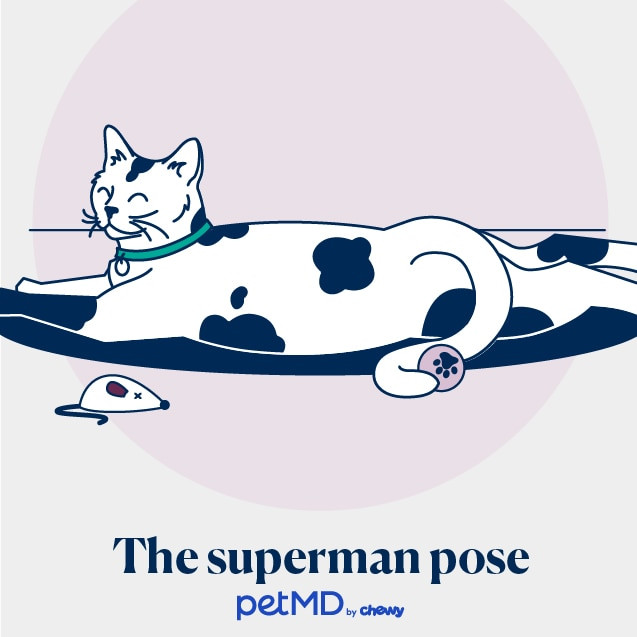 A cat is sprawled out in the superman pose, lying on its belly with legs extended forward and backward, indicating a relaxed and comfortable state, often seen when the cat feels warm.
A cat is sprawled out in the superman pose, lying on its belly with legs extended forward and backward, indicating a relaxed and comfortable state, often seen when the cat feels warm.
The amusing “Superman pose” features cats sleeping on their belly with front legs stretched forward and back legs stretched behind them, mimicking the iconic superhero in flight. This position indicates a more relaxed state than the loaf.
Although they appear completely relaxed, cats in the Superman pose still retain a degree of readiness. All four paws are extended and available for a quick getaway. This position also offers the benefit of protecting their vulnerable belly. Often, cats adopt this pose when they are warm, sometimes choosing cooler surfaces like tile or hardwood floors to stretch out on, especially during warmer weather. Conversely, they might choose a warm blanket for a cozy Superman nap in cooler temperatures.
6. Perched on Furniture or Appliances
 A cat is depicted sleeping soundly perched precariously on the narrow back of a sofa, highlighting their instinct to seek elevated and safe vantage points for rest.
A cat is depicted sleeping soundly perched precariously on the narrow back of a sofa, highlighting their instinct to seek elevated and safe vantage points for rest.
Finding cats sleeping perched in seemingly precarious spots, like the back of a couch, the arm of a chair, or even atop the refrigerator, might seem odd, but it’s rooted in their natural instincts. These elevated positions offer several advantages.
Firstly, a high vantage point provides safety from potential predators. In a domestic setting, “predators” might translate to other pets, children, or even unfamiliar visitors. Secondly, as predators themselves, a perched position allows cats a panoramic view of their territory, enabling them to keep an eye out for potential prey – even if that prey is just a favorite cat toy. Providing a cat tree with a high perch can satisfy this instinct and offer a safer alternative to your furniture.
7. Sleeping in Strange Positions
 A highly flexible cat is shown contorted into an unusual and seemingly uncomfortable sleeping position, emphasizing their remarkable spinal flexibility.
A highly flexible cat is shown contorted into an unusual and seemingly uncomfortable sleeping position, emphasizing their remarkable spinal flexibility.
Cats sleeping in positions that look incredibly uncomfortable to humans is a testament to their remarkable flexibility. Unlike dogs and humans, cats possess highly elastic spinal discs and shoulder blades loosely attached by muscle, granting them an exceptional range of motion.
What appears awkward to us is likely perfectly comfortable for your feline friend. Don’t be alarmed if you find your cat twisted into seemingly impossible shapes while napping; it’s simply showcasing their anatomical advantages.
8. Sitting Upright
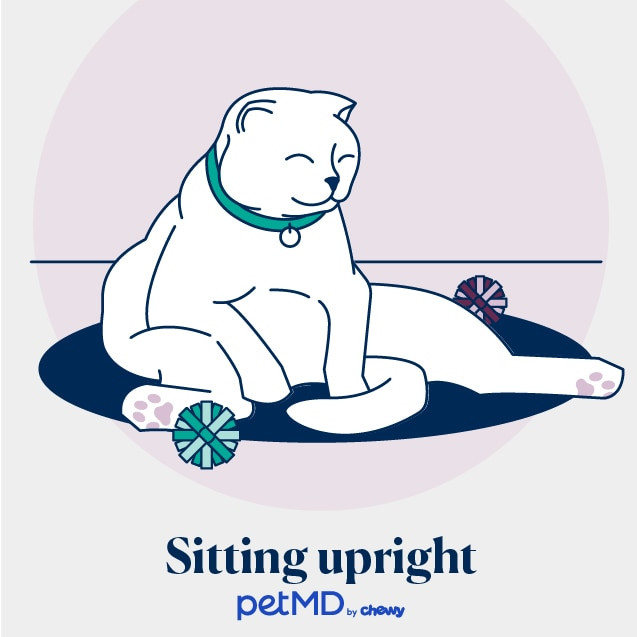 A cat is illustrated sleeping while sitting upright, with its paws tucked in, conveying a sense of relaxed security and slight exposure of the vulnerable belly.
A cat is illustrated sleeping while sitting upright, with its paws tucked in, conveying a sense of relaxed security and slight exposure of the vulnerable belly.
When cats sleeping are found sitting upright, it can be quite endearing, almost mimicking a human posture. This position, while seemingly less secure, actually indicates confidence and relaxation. A cat sleeping in a sitting position is exposing their belly, signifying they feel safe and unthreatened in their environment.
Furthermore, sitting upright provides easier access for grooming their belly, requiring less effort to reach and clean between naps. It may also offer some support for their back muscles, especially for older cats.
9. Sleeping on Your Chest
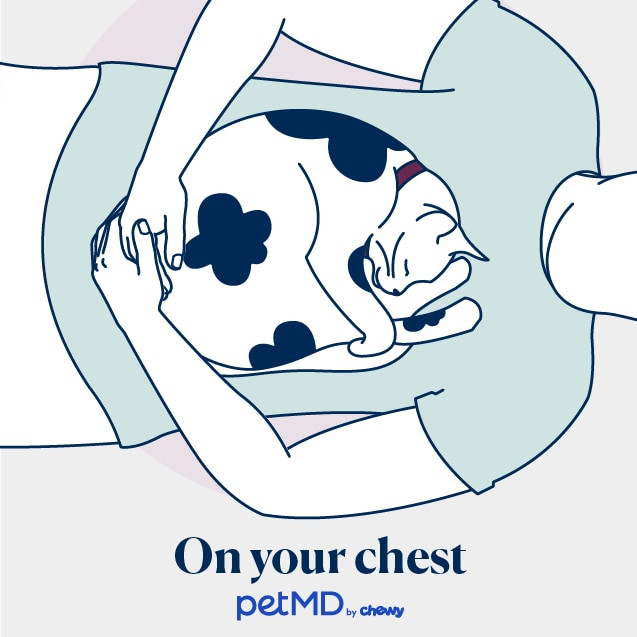 A cat is peacefully asleep on a person's chest, face nestled close, illustrating a strong bond and the cat's seeking of warmth, comfort, and closeness to their human companion.
A cat is peacefully asleep on a person's chest, face nestled close, illustrating a strong bond and the cat's seeking of warmth, comfort, and closeness to their human companion.
There are heartwarming reasons why cats sleeping choose to snuggle up on your chest. If your cat is deeply bonded to you, sleeping on your chest is a clear sign of affection and a desire for closeness. They simply want to be near their favorite human.
Beyond affection, your cat may also be drawn to the sound of your voice and the warmth of your body. The rhythmic sound of your heartbeat and breathing can be incredibly soothing, much like it is for infants. Your chest provides a cozy, warm, and comforting spot for a cat nap.
10. Sleeping Next to You
 A cat is shown sleeping peacefully right beside a person, maintaining physical proximity without being directly on top, indicating trust and a need for personal space.
A cat is shown sleeping peacefully right beside a person, maintaining physical proximity without being directly on top, indicating trust and a need for personal space.
Cats sleeping next to you, rather than directly on you, doesn’t signify a weaker bond. In fact, it also indicates trust. Sleeping in close proximity means your cat trusts you enough to be vulnerable while resting, but they may prefer a small buffer zone.
This position reflects a secure bond with a touch of independence. Your cat is saying, “I love you and trust you, but I also appreciate my personal space, at least for now.” It’s a comfortable compromise between closeness and independence.
11. Sleeping on Your Head
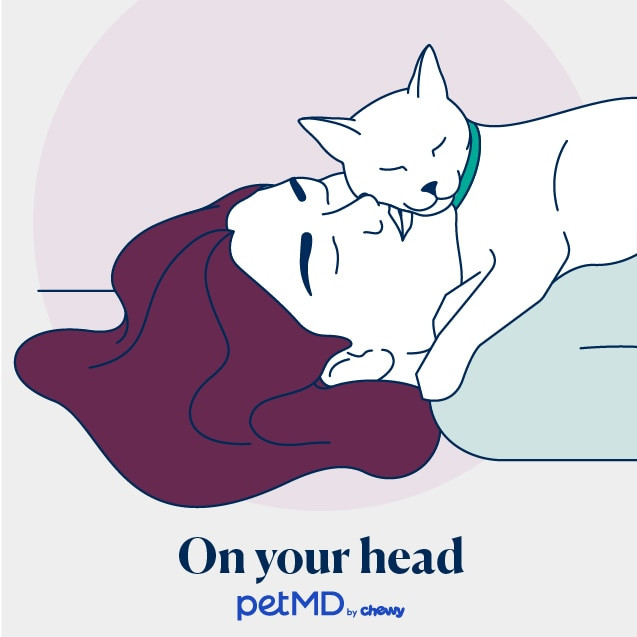 A cat is comfortably nestled and sleeping on a person's head, using the head and pillow as a soft, warm resting place, and seeking closeness to their owner.
A cat is comfortably nestled and sleeping on a person's head, using the head and pillow as a soft, warm resting place, and seeking closeness to their owner.
Finding cats sleeping on your head can be surprising, but there are logical reasons behind this behavior. Your head, especially when resting on a pillow, offers a soft and comfortable napping spot. Additionally, your head tends to move less than the rest of your body during sleep, providing a less disruptive environment for a light sleeper like a cat.
Furthermore, cats are creatures of habit and often adapt to your sleep schedule. Sleeping by your head allows them to be close to you while you both rest. Practically, it also gives them easy access to wake you up for food, attention, or any other needs they might have!
12. Sleeping on Your Feet
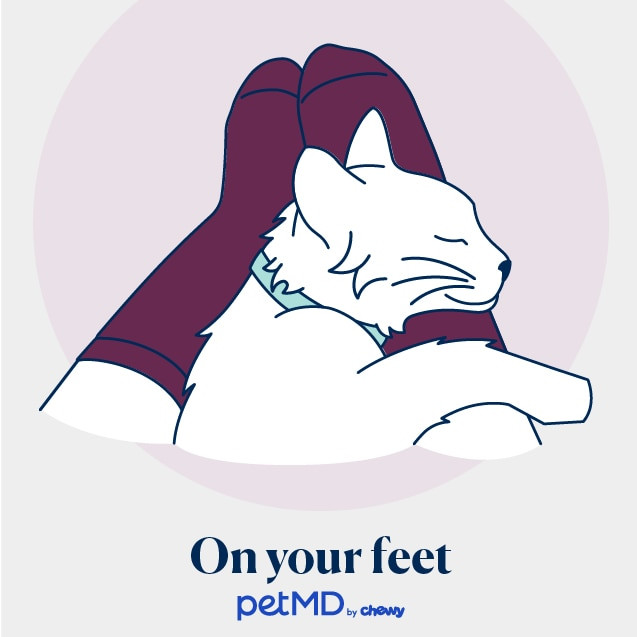 A cat is curled up and sleeping warmly on a person's feet, under the covers at the end of the bed, seeking warmth and closeness while maintaining a sense of security.
A cat is curled up and sleeping warmly on a person's feet, under the covers at the end of the bed, seeking warmth and closeness while maintaining a sense of security.
When cats sleeping choose your feet as their nap spot, they are likely seeking warmth from you. While they might be keeping your feet toasty, they are also benefiting from your body heat.
Sleeping at your feet allows them to be close to you while maintaining a sense of security. The foot of the bed, couch, or chair offers an easy escape route if they feel the need to flee, providing a balance of proximity and safety.
13. Sleeping Between Your Legs
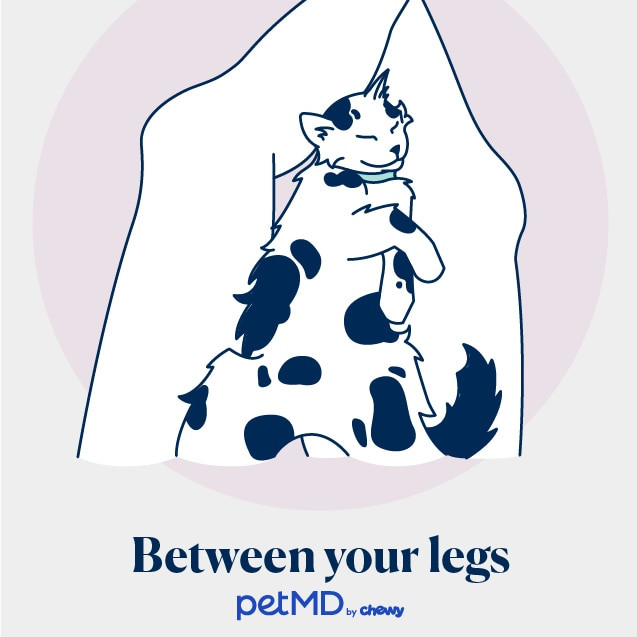 A cat is comfortably wedged and sleeping soundly between a person's legs, illustrating a secure, warm, and nest-like sleeping environment.
A cat is comfortably wedged and sleeping soundly between a person's legs, illustrating a secure, warm, and nest-like sleeping environment.
Cats sleeping between your legs might be less comfortable for you, but it offers several perks for your feline friend. This position allows for maximum closeness, and your legs create a warm, secure, and nest-like enclosure, perfect for a deep sleep.
Despite the feeling of being nestled, sleeping between your legs still provides a sense of security and an easy escape route if needed. It’s a cozy and safe haven for a cat seeking deep relaxation.
14. Sleeping in a Box
 A cat is contentedly sleeping inside a cardboard box, perfectly fitting within its confines, highlighting the feline attraction to enclosed spaces for security and comfort.
A cat is contentedly sleeping inside a cardboard box, perfectly fitting within its confines, highlighting the feline attraction to enclosed spaces for security and comfort.
The feline fascination with boxes is well-documented, and cats sleeping in boxes is a common sight. As prey animals, cats instinctively seek enclosed spaces to hide from potential threats. Boxes provide this sense of security, acting like a personal den.
Boxes also offer warmth and insulation, similar to a camping tent for humans. They provide a safe, enclosed space with an easy exit, just in case. When cats squeeze into boxes that seem too small, they are often seeking that feeling of security and snugness, akin to being swaddled.
15. Sleeping in the Litter Box
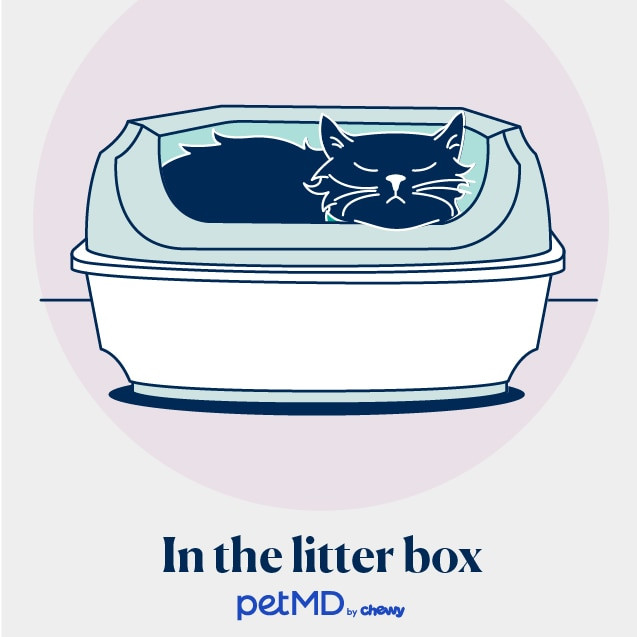 A cat is unusually found sleeping in its litter box, which is depicted as clean, emphasizing the importance of considering potential health issues if this behavior is observed.
A cat is unusually found sleeping in its litter box, which is depicted as clean, emphasizing the importance of considering potential health issues if this behavior is observed.
If you find your cat sleeping or even just resting in their litter box, it’s crucial to pay attention. This behavior is often a sign of an underlying medical issue, particularly urinary or digestive problems. Contact your veterinarian immediately if your cat starts sleeping in the litter box, as it could indicate a sudden change in their health.
While rare, some cats might develop a habit of sleeping in the litter box, or they might resort to it in stressful environments like animal shelters where safe sleeping spaces are limited. However, it’s always best to rule out medical causes first before attributing it to a behavioral quirk.
16. Sleeping with Eyes Open or Half Open
 A cat is shown sleeping with its eyes partially open, revealing the translucent third eyelid, which is a normal physiological feature but requires monitoring for any signs of eye problems.
A cat is shown sleeping with its eyes partially open, revealing the translucent third eyelid, which is a normal physiological feature but requires monitoring for any signs of eye problems.
Cats sleeping with their eyes fully or partially open might seem unsettling, but it’s often normal. You might even be able to observe rapid eye movement (REM) sleep in cats with their eyes slightly open, indicating they are likely dreaming.
Cats possess a translucent third eyelid that can be visible when they are sleeping. This membrane provides extra protection and moisture to the eye. While sleeping with eyes open can be normal, it’s important to monitor for any signs of eye problems. Consult your veterinarian if you notice eye swelling, discharge, squinting, pawing at the eye, or if the third eyelid is visible while your cat is awake, as these could indicate underlying issues.
17. Paws Over Eyes
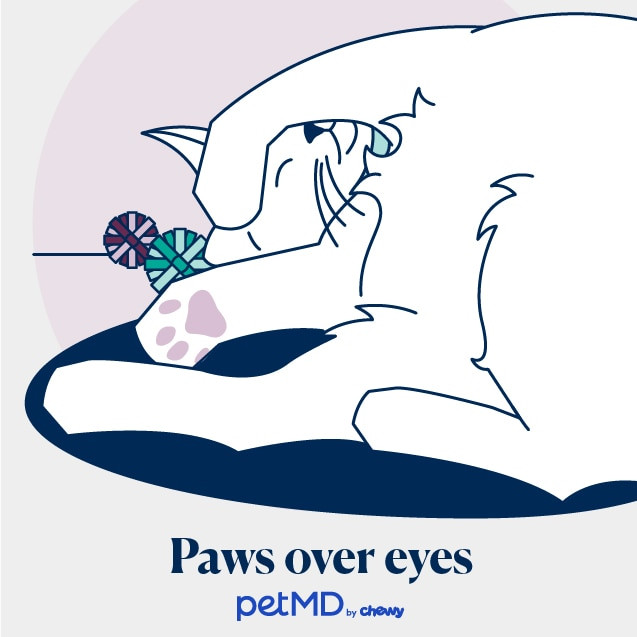 A cat is adorably sleeping with its paw covering its eyes, demonstrating a natural behavior to block out light and provide warmth and comfort to the face.
A cat is adorably sleeping with its paw covering its eyes, demonstrating a natural behavior to block out light and provide warmth and comfort to the face.
The endearing sight of cats sleeping with their paws covering their eyes is not just cute; it serves a practical purpose. Paws over the eyes can provide insulation and warmth for both the paws and the face, acting like cozy mittens and a built-in face warmer.
Furthermore, paws function as natural sleeping masks, blocking out harsh light and even keeping away dust or pollen, ensuring a more comfortable and undisturbed nap.
18. Sleeping With Other Cats
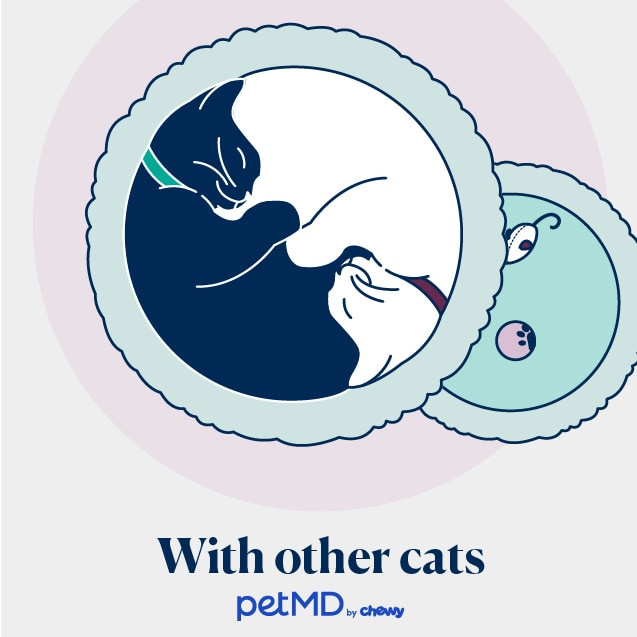 Two cats are pictured curled up together and sleeping peacefully in a shared cat bed, highlighting the social bonding and mutual warmth provided by feline companionship.
Two cats are pictured curled up together and sleeping peacefully in a shared cat bed, highlighting the social bonding and mutual warmth provided by feline companionship.
While some cats in multi-cat households might simply tolerate each other, many cats enjoy companionship and will choose to sleep together. This can range from sharing the same comfortable bed to snuggling up closely.
Sleeping together can be a sign of a strong bond and mutual affection. Group sleeping also provides shared warmth, and the soothing sound of another cat’s purr can enhance relaxation and comfort.
19. Sleeping With a Dog
 A cat and a dog are peacefully sleeping side-by-side, showcasing interspecies bonding and the potential for harmonious coexistence and mutual comfort in a multi-pet home.
A cat and a dog are peacefully sleeping side-by-side, showcasing interspecies bonding and the potential for harmonious coexistence and mutual comfort in a multi-pet home.
Despite their stereotypical rivalry, cats and dogs can sometimes form strong bonds. While introductions should always be careful and supervised, cats that have developed a positive relationship with a dog may choose to sleep alongside their canine companion.
In these instances, sleeping together signifies companionship, warmth, and mutual comfort. It’s a testament to the capacity for interspecies friendships and the ability to find comfort and security in unexpected bonds.
20. Tucked In
 A cat is snugly tucked under a blanket, with just its head peeking out, enjoying the warmth, security, and darkness offered by being burrowed under covers.
A cat is snugly tucked under a blanket, with just its head peeking out, enjoying the warmth, security, and darkness offered by being burrowed under covers.
If your cat loves to sleep under the covers, they are likely relishing the warmth and the comforting familiarity of your scent lingering in the bedding.
Beyond warmth, blankets can provide a sense of security and a refuge from stressful noises. Some cats simply enjoy the feeling of being wrapped or swaddled. While generally safe, always be mindful of your cat’s location under blankets to avoid accidentally disturbing or injuring them. Ensure the bedding is breathable for their safety and comfort.

